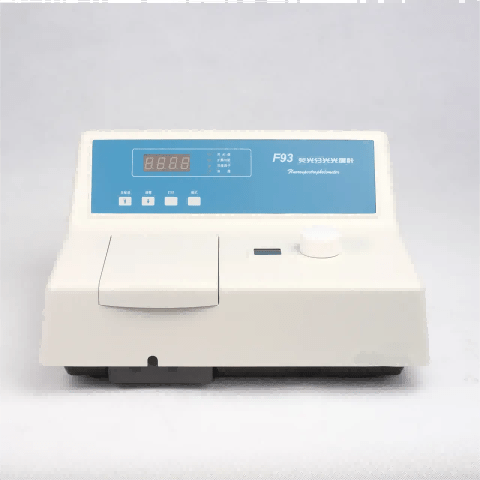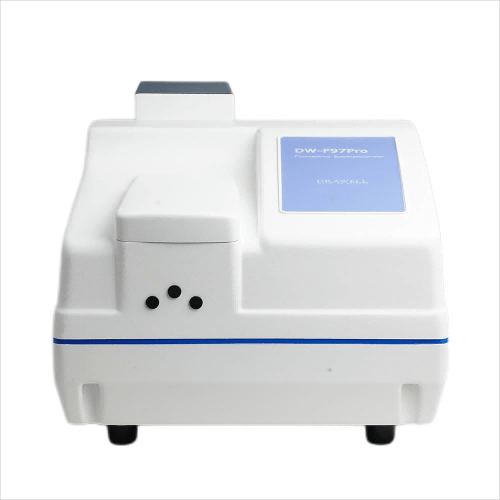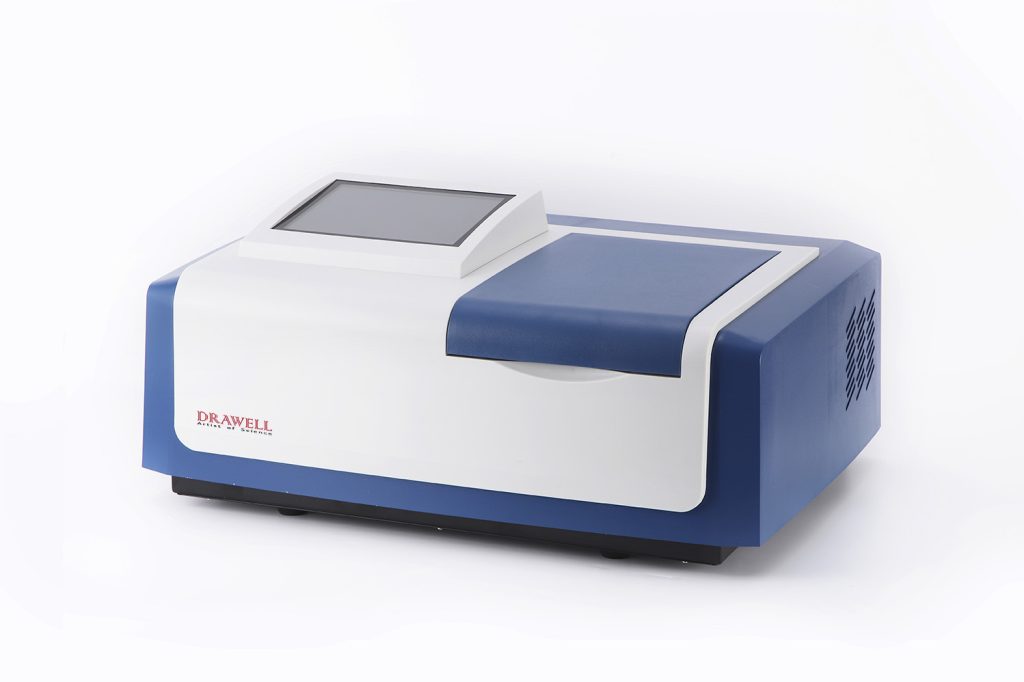In the world of spectroscopy, both fluorescence spectrophotometers and UV-vis spectrophotometers are widely used for analyzing substances, but they work based on different principles and are suited for different types of analysis. Understanding the distinctions between the two types of spectroscopy instruments is crucial for selecting the right one for specific applications.

Key Differences and Similarities between Fluorescence Spectrophotometers and UV-vis Spectrophotometers
1. Principles of Operation
Fluorescence Spectrophotometer
A fluorescence spectrophotometer measures the fluorescence emitted by a sample after it has absorbed light. The sample is excited using a specific wavelength of light, which causes it to emit light at a longer wavelength. The intensity of this emitted light is measured to determine the concentration or properties of the sample. Fluorescence is highly sensitive, enabling detection of minute quantities of analytes.

UV-Vis Spectrophotometer
A UV-Vis spectrophotometer measures the amount of light absorbed by a sample in the ultraviolet and visible (UV-vis) spectrum. The absorbance of light at specific wavelengths is used to calculate the concentration of substances in the sample. Unlike fluorescence, UV-Vis does not involve emission of light but rather absorption, and it typically measures a broader range of molecules.

2. Measurement Sensitivity
Fluorescence Spectrophotometer
Fluorescence is a highly sensitive technique, often detecting substances at the nanomolar or even picomolar concentration levels. The technique amplifies the signal through the emission process, making it ideal for detecting low-abundance analytes in complex mixtures.
UV-vis Spectrophotometer
UV-vis is less sensitive compared to fluorescence, typically operating in the micromolar concentration range. It is well-suited for samples with higher concentrations, but its sensitivity decreases for low-concentration substances.

3. Applications
Fluorescence Spectrophotometer
- Commonly used in biochemical, pharmaceutical, and environmental studies.
- Ideal for detecting fluorescent compounds, biomolecules (e.g., proteins, DNA, and vitamins), and certain metal ions.
- Useful in applications like studying protein-ligand interactions, drug discovery, and environmental monitoring of pollutants.
UV-vis Spectrophotometer
- Widely used in chemical, pharmaceutical, and environmental industries.
- Suitable for analyzing chromophores (molecules that absorb light), such as organic compounds, transition metal ions, and nanoparticles.
- Applications include quantifying concentrations of solutions, monitoring reaction kinetics, and determining the purity of compounds.

4. Advantages
Fluorescence Spectrophotometer
- High sensitivity allows for detection of trace amounts.
- Selective analysis by exciting specific fluorescent molecules in a mixture.
- Can provide insights into molecular environment changes, interactions, and dynamic behavior.
UV-Vis Spectrophotometer
- Simple and fast analysis with minimal sample preparation.
- Broad applicability to a wide range of compounds.
- Non-destructive and can analyze turbid or colored samples without complex setup.
5. Limitations
Fluorescence Spectrophotometer
- Fluorescence requires specific molecules that can fluoresce, limiting the range of samples that can be analyzed.
- Interference from quenching agents or background fluorescence can affect accuracy.
- Fluorescence intensity can be highly dependent on environmental factors, such as pH and temperature.
UV-vis Spectrophotometer
- Lower sensitivity compared to fluorescence, making it less effective for low-concentration analyses.
- Absorbance readings can be affected by impurities, scattering, and turbidity in the sample.
- Often requires more sample volume than fluorescence measurements.
6. Cost and Complexity
Fluorescence Spectrophotometer
- More expensive due to the advanced technology required for excitation and detection of fluorescence.
- Requires periodic calibration and maintenance to ensure precise measurements.
- More complex to operate due to the additional steps in excitation and emission measurement.

UV-vis Spectrophotometer
- Generally more affordable, making it a popular choice for routine laboratory analysis.
- Easier to maintain and operate, with a simpler design that reduces the need for frequent calibration.
- Suitable for entry-level users and labs requiring quick, reliable results.
Key Factors for Choosing between Fluorescence Spectrophotometers and UV-Vis Spectrophotometers
This chart provides a clear comparison to help in deciding which spectrophotometer suits specific analytical needs.
| Factor | Fluorescence Spectrophotometer | UV-vis Spectrophotometer |
| Sensitivity | Extremely high, can detect nanomolar to picomolar concentrations. | Moderate sensitivity, typically detects micromolar concentrations. |
| Type of Sample | Suitable for samples containing fluorescent molecules or labeled samples. | Works well for compounds that absorb in the UV and visible range. |
| Applications | Biochemistry, molecular biology, environmental monitoring, trace analysis. | Chemistry, pharmaceuticals, environmental science, routine lab work. |
| Cost | More expensive due to complex detection systems. | Generally more affordable and suitable for routine use. |
| Complexity | Requires specialized knowledge for operation and calibration. | Easier to use and requires minimal training for basic measurements. |
| Dynamic Measurements | Capable of studying real-time biochemical interactions and molecular changes. | Limited to absorbance measurements without dynamic or real-time tracking. |
| Detection Range | Excellent for trace analysis and detecting very low concentrations. | Suitable for higher concentration ranges. |
| Maintenance | Requires regular calibration and maintenance due to sensitivity of equipment. | Less frequent maintenance, simpler calibration process. |
| External Influences | More sensitive to temperature, pH, and solvent variations affecting results. | Less affected by external conditions like temperature and pH. |
| Labeling | Requires fluorescent labeling for non-fluorescent compounds. | No labeling required; measures natural absorbance. |
| Speed of Analysis | Slightly longer due to emission and excitation process. | Faster with direct absorbance measurement. |
| Common Uses | DNA/protein analysis, contaminant detection, pharmaceutical research. | Compound concentration, color analysis, quality control in industries. |
Both fluorescence spectrophotometers and UV-vis spectrophotometers offer unique advantages depending on the application, sensitivity requirements, and type of analysis being performed.
- Fluorescence spectrophotometers excel in detecting low concentrations of fluorescent molecules, offering high sensitivity for research in biochemistry, environmental monitoring, and pharmaceutical development.
- UV-vis spectrophotometers are more versatile and cost-effective for general-purpose analysis in industries like pharmaceuticals, chemistry, and environmental science.

Selecting the appropriate spectrophotometer depends on the specific needs of the application, including the type of analyte, required sensitivity, and budget considerations. For high-sensitivity detection of fluorescent molecules, fluorescence spectrophotometry is the preferred choice, while UV-vis spectrophotometry serves as a robust, efficient solution for broader applications.








